Mavia › Sardis » Ancient origins
Articles and Definitions › Contents
- Mavia › Who Was
- Sardis › Antique Origins
Ancient civilizations › Historical and archaeological sites
Mavia › Who Was
Definition and Origins
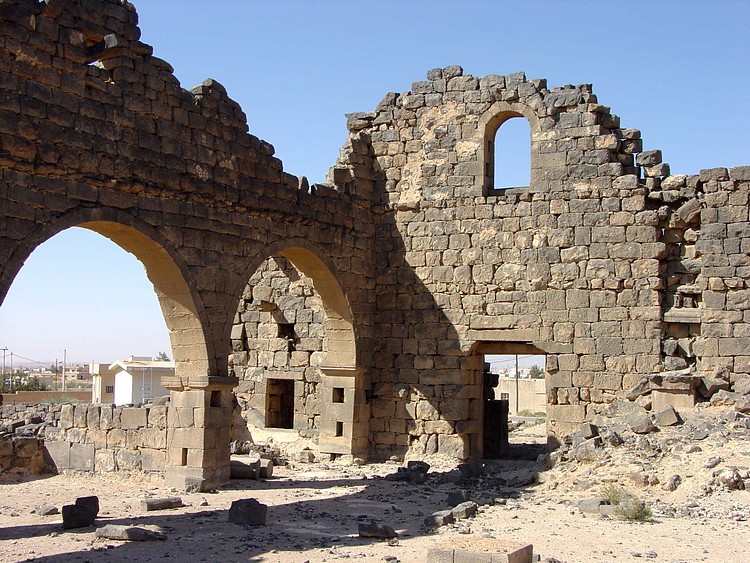
Mavia (rc 375-c. 425 CE) was a warrior-queen of the semi-nomadic Tanukhid Arab tribe of Syria and Jordan who led a successful insurrection against Rome in 378 CE. She is also known as Maowiva, Mu`awiya, Mauia, Mania, and Mawiyya. Her control of southern Syria into Jordan seems certain but how far she extended that control beyond is contested. She rose to power after the death of her husband (whose identity is unknown) described as either a “king” or “phylarch” (meaning “ruler of a tribe”), and is only known through her rebellion against Rome in which she emerged triumphant and was able to dictate terms.
Although she is referred to as “Queen of Syria”, this designation is not accurate. Mavia never ruled Syria itself but led a coalition of Arab tribes in that region. The causes of her revolt are unknown but may have had something to do with Rome's demand for men from her lands as auxiliaries in their army.
Following her victory, Mavia was powerful enough to be able to dictate the terms of negotiations. She demanded that a certain orthodox Christian monk, Moses, be named as bishop over her people. This seems to have been the only stipulation for terms which some have interpreted as meaning Mavia and her people were Christian. The ancient historians, however, clearly suggest that they were not. They were most likely pagans who admired Moses for his devotion to his god and wanted him as their spiritual leader.
Her demand was met and Moses negotiated the peace; afterwards he became bishop of the tribes. Mavia gave her daughter in marriage to the Roman commander-in-chief Victor, to seal the peace, and later sent troops from her coalition to guard the city of Constantinople following the Roman defeat by the Goths at the Battle of Adrianople in August 378 CE.
MAVIA'S TRIBE, UNDER HER HUSBAND'S LEADERSHIP, WERE FOEDERATI OF ROME & SERVED AS AUXILIARIES IN THE ROMAN ARMY IN EXCHANGE FOR CERTAIN BENEFITS ROME PROVIDED.
She is assumed to have ruled until at least c. 425 CE, though this is disputed, and nothing is known of her death. She is frequently compared to the more famous queen Zenobia of Palmyra (rc 270-272 CE) who also challenged Rome.
SOURCES
The primary source for her story is Rufinus of Aquileia (c. 345-411 CE) who provides the only contemporary account of her revolt in his Ecclesiastical History Book XI.6. Socrates Scholasticus (c. 380-439 CE) narrates the same story in his Ecclesiastical History Book IV.36. The historian Theodoret of Cyrus (c. 393-c.458 CE) also records Mavia's rebellion ( Ecclesiastical History Book IV.20) and his account is followed by Sozomen (c. 400-450 CE) who calls the queen Mania and expands on the story in his History (Book VI:38).
Any later accounts of Mavia's rebellion draw on these four authors as well as the text known as the Ammonii Monachi Relatio(between c. 373 and c. 377 CE) which gives an account of the massacre of monks by Saracens at the monasteries of Mt. Sinai and Rhaithou. This work mentions a monk “Moses” which some scholars suggest is the same man Mavia so admired. This Moses is spared in the Saracen attack but no reason is given and it is also unclear what prompted the massacre. Although the Ammonii Monachi Relatio has been tentatively dated to c. 373 CE, it makes more sense to date it at c. 377 or 378 CE, closer to the time of Mavia's rebellion in the area which it seems to be narrating.
THE TANUKHIDS AS ROMAN FOEDERATI
Mavia's tribe, under her husband's leadership, were foederati of Rome. The foederati were nation-states or tribes who served as auxiliaries in the Roman army in exchange for certain benefits Rome provided. This arrangement was brokered by the king or phylarch of a nation-state or tribe and the emperor of Rome but seems to have only held good during the reigns of those leaders who had entered into it. A successor had no obligation to provide the same service unless a new arrangement was made when they came to power.

Valens
The Tanukhids had migrated to the region of modern-day Jordan sometime in the 2nd century CE but there is evidence that there were members of the tribe there earlier on who shared in the prosperity of the Kingdom of Nabatea (c. 168 BCE-106 CE). When the Nabatean kingdom fell, the region was annexed by Rome and the tribes which had formed the Nabatean coalition aligned with or against Rome; the Tanukhids chose Rome though it is unclear precisely why or when. All that is known for sure is that they were Roman foederati under Mavia's husband.
Foederati were expected to fight for Rome when called upon and this policy would have been adhered to by Mavia's husband.After his death, however, she seems to have had the right to call for negotiations to form a new agreement and this right may have been ignored by Rome who perhaps assumed she would continue to meet her late husband's obligations.
MAVIA WAS CLEARLY A VERY CAPABLE MILITARY COMMANDER. SHE LED HER ARMIES PERSONALLY & RAVAGED THE REGION FROM SYRIA THROUGHOUT THE LEVANT, SCATTERING ANY OPPOSITION SENT AGAINST HER.
Rome in the 4th century CE was battling a number of different incursions and, under emperor Valens (r.364-378 CE), was having difficulty dealing with the Goths. The Goths had first appeared in Roman territories in 238 CE and made periodic, and destructive, raids afterwards; the most famous being under the Goth king Cniva (c. 250-c. 270 CE) who killed the Roman emperor Decius (249-251 CE) and his successor at the Battle of Abritus in 251 CE.
Valens had fought the Goth king Athanaric (d. 381 CE) between 367-369 CE and had welcomed Athanaric's rival king Fritigern (d. 380 CE) into Roman territories when the latter had requested asylum from the invading Huns. Once inside Rome's borders, however, provincial governors treated the Goths under Fritigern so poorly that they revolted, instigating the First Gothic War of 376-382 CE. Valens required manpower to put down this revolt and called on his foederati to supply troops.Mavia most likely refused because she had not been contacted prior to this demand to negotiate a new deal for the Tanukhids as foederati of Rome. It should be noted, however, that no clear reason for the revolt is given by the ancient historians.
MAVIA'S REVOLT
The accounts do make clear that Mavia's insurrection was well organized and that she was a very capable military commander who destroyed large areas of the region and scattered any opposition sent against her. Mavia led her armies personally and ravaged the region from Syria throughout the Levant. Sozomen's description is the most detailed of the accounts:
About this period, the king of the Saracens died and the peace which had previously existed between that nation and the Romans was dissolved. Mania [Mavia], the widow of the late monarch, after attaining to the government of her race, led her troops into Phoenicia and Palestine, as far as the regions of Egypt lying to the left of those who sail towards the source of the Nile, and which are generally denominated Arabia. This war was by no means a contemptible one, although conducted by a woman.The Romans, it is said, considered it so arduous and so perilous that the general of the Phoenician troops applied for assistance to the general of the entire cavalry and infantry of the East. This latter ridiculed the summons and undertook to give battle alone. He accordingly attacked Mania, who commanded her own troops in person, and he was rescued with difficulty by the general of the troops of Palestine and Phoenicia. Perceiving the extremity of the danger, this general deemed it unnecessary to obey the orders he had received to keep aloof from the combat; he therefore rushed upon the barbarians and furnished his superior an opportunity for safe retreat, while he himself yielded ground and shot at those who fled, and beat off with his arrows the enemies who were pressing upon him. This occurrence is still held in remembrance among the people of the country and is celebrated in songs by the Saracens. (Book VI:38)
According to the ancient accounts, Mavia's army was invincible as she swept through the region. Rufinus writes that she “disturbed” the regions of Palestine and Arabia and “lay waste to neighboring provinces” (XI.6) while Socrates Scholasticus claims that “all the regions of the east were at that time ravaged by the Saracens” (IV.36) and Theodoret relates how “At this time, the Ishmaelites [Saracens] were devastating the country in the neighborhood of the Roman frontier. They were led by Mavia, a princess, who regarded not the sex which nature had given her and displayed the spirit and courage of a man” (IV.20).

Queen Zenobia's Last Look Upon Palmyra
When the Romans realized they could not defeat her, they sought terms of peace and, according to all the accounts, Mavia had only one: she wished a certain monk of her region to be made bishop of her people. Although this demand has been interpreted to mean that Mavia and her people were Christian, this is not necessarily so and, as noted, is not supported by the ancient accounts.
MOSES NEGOTIATES THE PEACE
Those who argue that Mavia was an orthodox Christian claim that she was opposed to the ordination of an Arian Christian bishop over her Nicene Christian tribe. Valens was an Arian Christian and so were many of the bishops and clerics then serving the church of Rome; Moses was a Nicene Christian and so, it is assumed by some scholars, were Mavia's people.
Arians were Christians who claimed that Jesus was a created being, begotten of God, while orthodox Nicene Christians believed he was one with God, never created, and eternal. The difference in these beliefs is that the Arians were claiming Jesus was a demi-god while the Nicene Christians held he was God. It is clear from the accounts that Moses was an orthodox Christian but this does not mean that Mavia or her tribe were. Sozomen makes clear that there were few Christians in Mavia's tribe when Moses became their bishop and he converted them after he had made peace between them and Rome.
Moses is described as an Arab Christian who lived a life of seclusion and it has been established that Christian monks, by living blameless lives of devotion, had a significant impact on the conversion of pagan Arabs to Christianity at this time. It is far more likely that Mavia chose Moses as her tribe's spiritual leader based on his personal merits rather than that she was an orthodox Christian objecting to an alleged proposal by Rome that she accept an Arian bishop.
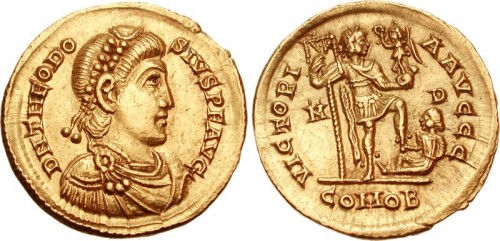
Theodosius I Solidus
The original accounts of the rebellion, and Moses as negotiator, mention the Arian bishop Lucius of Alexandria as the man who would have to ordain Moses as bishop. They do not, however, emphasize the conflict between Arian and Nicene Christians so much as Moses' personal disdain for Lucius. Socrates Scholasticus notes how, after the Romans and Mavia had agreed to terms:
Moses was accordingly seized, and brought from the desert to Alexandria, in order to be initiated in the sacerdotal functions: but on his presentation for that purpose to Lucius, who at that time presided over the churches in that city, he refused to be ordained by him, protesting against it in these words: “I account myself indeed unworthy of the sacred office; but if the exigencies of the state require my bearing it, it shall not be by Lucius laying his hand on me, for it has been filled with blood.” When Lucius told him that it was his duty to learn from him the principles of religion, and not to utter reproachful language, Moses replied, “Matters of faith are not now in question; but your infamous practices against the brethren sufficiently prove the inconsistency of your doctrines with Christian truth. A Christian is no striker, reviles not, does not fight; for it becomes not a servant of the Lord to fight. But your deeds cry out against you by those who have been sent into exile, who have been exposed to the wild beasts, and who have been delivered up to the flames. Those things which our own eyes have beheld are far more convincing than what we receive from the report of another.” (IV.36)
Here, Moses says nothing of Arianism; his objection is entirely to Lucius' personal behavior. He refuses to be ordained by Lucius and is instead consecrated as bishop by orthodox Christians living in exile. There is nothing to suggest Mavia's Christianity and nowhere in the accounts is there any mention that Valens or anyone else intended to place an Arian bishop over Mavia's tribe.
Mavia most likely rebelled against Rome because she had been slighted as queen. The Romans had assumed she would honor her husband's agreement with them but did not show her the respect of negotiating with her directly. After their treatment of the reaching of the peace accord, the accounts do not mention Arian or Nicene Christians in the equation. To finalize the peace, Mavia gave her daughter in marriage to a Roman officer named Victor, commander-in-chief of the army, and the narrative of her rebellion ends.
CONCLUSION
Once peace was made, and Valens no longer had to worry about a widespread insurrection in the region, he turned his attention to the Goths. He met Fritigern and his army at the Battle of Adrianople where he was killed and the Roman army defeated in August 378 CE. In the aftermath of the battle, when Rome feared imminent attacks by the Goths on their cities, Mavia sent cavalry to defend Constantinople.
Theodosius I (379-395 CE) negotiated peace with the Goths sometime around 382 CE but the terms seem to have been so favorable that the Tanukhids felt betrayed and revolted again in 383 CE. Mavia is not mentioned in this revolt and it is possible she had already died and her unknown successor raised the insurrection. It is believed, however, that she was still queen in c.425 CE based on an inscription dated to that year which bears her name.
Scholar Irfan Shahid is the main proponent for accepting this date but other scholars have noted that "Mavia" was a common name at that time and the inscription could be referencing another woman. Shahid, however, points out that the inscription is more likely to refer to the famous queen than an unknown woman of the same name; his claim has more or less been accepted.
How she reigned and what happened to her after the revolt is unknown but she is depicted as a brilliant and ruthless queen and military commander. The ancient accounts all explicitly mention or imply that she was initially dismissed by the Romans because she was a woman and how their assumption that a woman could be no threat cost them dearly. There is almost a note of satisfaction in Sozomen's tone as he describes the arrogance of the Roman commander who has to be rescued by his subordinate from Mavia's onslaught. Whatever her final fate may have been, she made a significant impression on her enemies whose historians immortalized her in often glowing phrases.
Sardis › Antique Origins
Definition and Origins
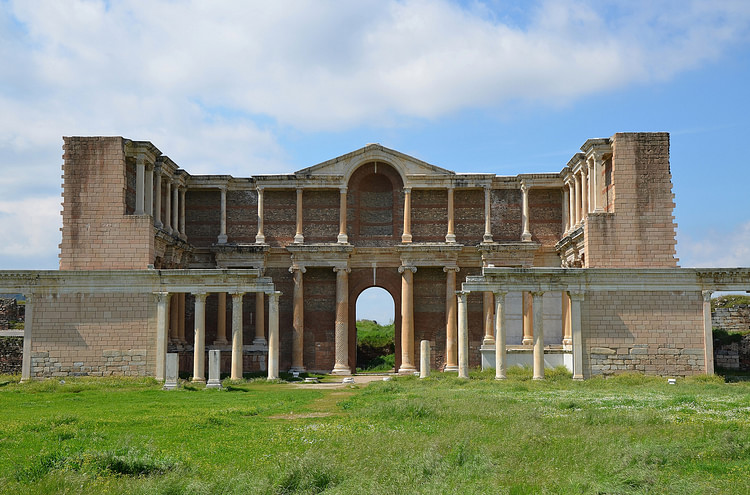
Sardis was an important ancient city and capital of the kingdom of Lydia, located in western Anatolia, present-day Sartmustafa, Manisa province in western Turkey. Its strategic location made it a central point connecting the interior of Anatolia to the Aegean coast. During its history, control of Sardis changed many times, but it always kept a high status among cities.
THE ORIGIN OF SARDIS
Around 612 BCE, the greatest city in the world at that time, Nineveh, was besieged and sacked by an allied army of Persians, Medes, rebelling Chaldeans, and Babylonians, putting an end to the Assyrian Empire. This event shaped a new political map: Babylon became the imperial centre of Mesopotamia and the kingdom of Lydia became the dominant power in western Anatolia with Sardis as its capital.
The life of Sardis began as a hilltop citadel where the king of Lydia lived. The city developed into a two part town: the lower town, located along the banks of the Pactolus river, where the ordinary citizens lived, and the upper town for the wealthy citizens, royal members, and the palace. Herodotus wrote that the lower town was a modest place with many of its houses made of reeds from the river and with no surrounding wall.
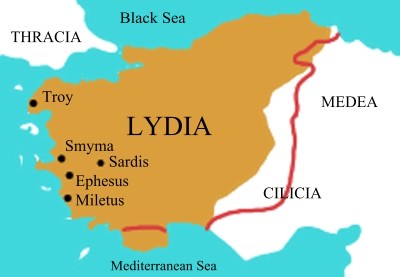
Map of Lydia
RELATIONS WITH THE GREEK WORLD
To the west, Lydia had the Greek colonies of Ionia. After the fall of Assyria, Lydia was free to turn its attention to the Ionian cities, which became dominated by Lydia. Lydian rulers, however, admired the Greeks and treated the Ionian cities leniently.Moreover, Croesus, the last Lydian king, even paid for the construction of the temple of Artemis, which became one of the Seven Wonders of the Ancient World. Thus, the Ionian coast city-states and the Lydians remained on peaceful terms with very tight cultural and commercial relations. Sardis was a centre for the traffic of goods and ideas between Mesopotamia and the Greek Ionian settlements, a crossroad of trade, and an ideal meeting point for the exchange of ideas, beliefs, customs, knowledge, and new insights. This rich exchange was one of the factors that, around 600 BCE, allowed the Ionian cities to turn into the intellectual leaders of the Greek world.
SARDIS WAS A CENTRE FOR THE TRAFFIC OF GOODS AND IDEAS BETWEEN MESOPOTAMIA AND THE GREEK IONIAN SETTLEMENTS.
Herodotus (1.31) claims that on one occasion Sardis was visited by Solon, a famous Athenian lawmaker and statesman and one of the seven proverbial wise men of ancient Hellas, who met Croesus, the Lydian king. This meeting between Solon and Croesus is certainly a fiction: Solon, if we trust the current accepted chronology, must have been dead several years before 560 BCE, the year when Croesus became king of Lydia. Nevertheless, according to the story Croesus was overjoyed to have such an important visitor and was anxious to display his wealth to the well-travelled Solon. Croesus finally asked Solon who, of all the men he had met in his travels, he would call the most happy. Solon replied, “Tellus of Athens.” This made Croesus upset since he expected to be named first. Solon added that Tellus had lived well and happily, had a beautiful family, and had died gloriously for Athens in battle. Croesus agreed this was a good life and asked Solon who else he would consider to be among the happiest of men he had met, hoping he would at least be named second. Solon answered “ Cleobis and Biton ”, two Greek brothers who had enough resources to live, great fitness levels, and who had died honourably. Croesus, angered now, shouted, "My Athenian guest, are you disparaging my own happiness as though it were nothing?, Do you think me less than a common man?" Solon replied that no person can be judged fortunate until their death: "I cannot yet tell you the answer you asked for until I learn how you have ended your life."
PERSIAN CONTROL
When Cyrus II, King of Persia, invaded Sardis in 547 BCE, it became obvious that the lack of a defensive wall protecting the lower city was not a wise choice. The Lydian king Croesus simply retreated to the upper town, and the Persian army controlled the lower city with very little resistance. The Persian army finally found an unguarded spot in the citadel's defences, and Sardis came under Persian control for the next two centuries.
During the Persian occupation, Sardis did not change much: A Persian garrison was built on the acropolis while the lower town settlements remained unchanged. An altar of Artemis is mentioned by Xenophon, possibly in the southern portion of the acropolis, in the settlements along the river, where some time later a temple to the goddess was built.
Once Sardis was taken, the Persians also occupied the Ionian cities. About 500 BCE, the Ionian cities dismissed the Persian authorities and declared their independence, triggering the Ionian revolt with the city of Miletus as the leading state, the first of many military conflicts between Greeks and Persians. A Greek army marched upon Sardis and burned it to the ground. This is how Herodotus reports the incident:
When the Athenians, the Eretrians, and the rest of the allies had arrived and were present in Miletus, Aristagoras organized an expedition against Sardis. [...] they journeyed inland in massive force, with Ephesians as their guides. They travelled along the Cayster River, crossed over Mount Tmolus, and came to Sardis, where they captured the city without resistance from anyone whatsoever. They took control of everything except the acropolis. For Artaphernes [the brother of the Persian king, Darius I ] himself defended the acropolis with a rather large force of men.Although they had taken the city, they were unable to plunder it because most of the houses in Sardis were constructed of reeds [...] and when a soldier set one of these houses on fire, the flames spread rapidly from house to house until they engulfed the entire city.(Herodotus, 5.99-101)
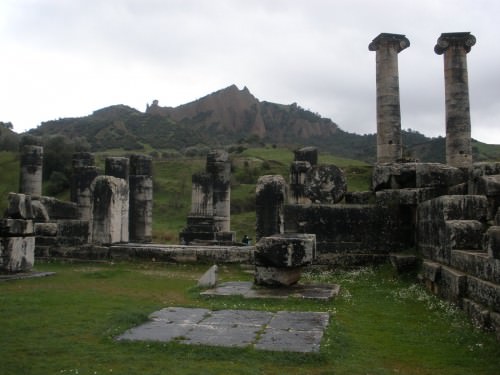 TEMPLE OF ARTEMIS AT SARDIS
TEMPLE OF ARTEMIS AT SARDIS

MACEDONIAN & SELEUCID CONTROL
A number of changes took place in Sardis after the city surrendered to Alexander the Great in 334 BCE. A new lower town was built to the north of the Acropolis and the old town was gradually abandoned, with the sole exception of the Temple of Artemis and its surrounding area, where a few citizens continued to live. The new lower town had the east-west road as its axis which connected the interior to the coast.
A number of Hellenistic public buildings were built in the new town including a stadium and a theatre. The city was walled at some point before the year 215 BCE as attested to by ancient reports that, when the troops led by the Seleucid ruler Antiochus III assaulted Sardis that year, they penetrated across a section of the city wall near the theatre. Sardis was then made Seleucid's administrative centre for the Anatolia region.
ROMAN CONTROL
Sardis came under Roman rule in 133 BCE. During this time, it remained an important city and was the principal centre of a judicial district that included almost 30 Lydian and Phrygian settlements. The city was eventually made a provincial capital when Lydia was re-established as an administrative centre.
Tacitus reports an earthquake that affected the city in 17 CE:
That same year twelve famous cities of Asia fell by an earthquake in the night, so that the destruction was all the more unforeseen and fearful. Nor were there the means of escape usual in, such a disaster, by rushing out into the open country, for there people were swallowed up by the yawning earth. Vast mountains, it is said, collapsed;what had been level ground seemed to be raised aloft, and fires blazed out amid the ruin. The calamity fell most fatally on the inhabitants of Sardis, and it attracted to them the largest share of sympathy.(Tacitus, 2.47)
During the second and early 3rd century CE, the city expanded to the west. At the beginning of the 5th century a wall enclosing 156 hectares was built. Then in the year 616 CE, Sardis' life came to an end. A Persian army penetrated the Roman defensive lines that had been deployed in eastern Anatolia. Soon after, part of that region fell to the Persians, including Sardis.The city fortifications could not do much to stop the Persian troops, and Sardis was sacked and devastated so completely that no attempt to restore the city has been recorded. This incident constitutes the end of Sardis' civic life. A military detachment regained the citadel in 660 CE, but the town itself remained empty and all subsequent references to Sardis are to the castle on the hill, never to the town.
SARDIS TODAY
Since 1958 CE, the universities of Harvard and Cornell have been performing annual excavations at Sardis. As part of these works, Sardis' gymnasium has been restored and the synagogue was discovered in 1962 CE, a building measuring over 91.4 metres (300 feet) in length. Some of the important finds from the archaeological site of Sardis are kept in the Archaeological Museum of Manisa in Turkey, including many Roman mosaics and sculptures and pottery from different periods in the history of the city.
LICENSE:
Article based on information obtained from these sources:with permission from the Website Ancient History Encyclopedia
Content is available under License Creative Commons: Attribution-NonCommercial-ShareAlike 3.0 Unported. CC-BY-NC-SA License